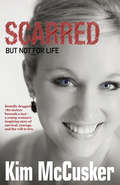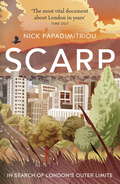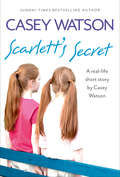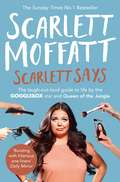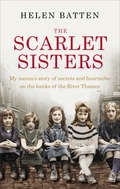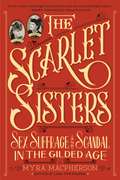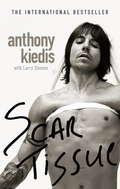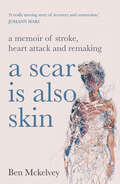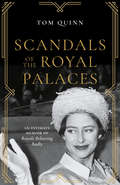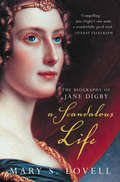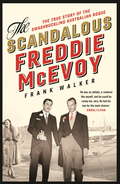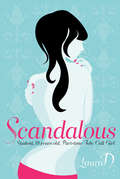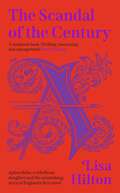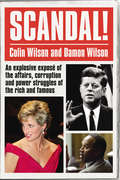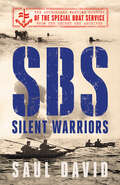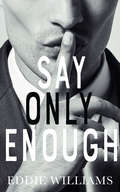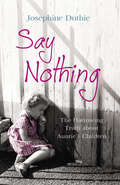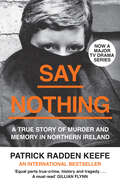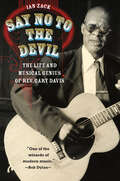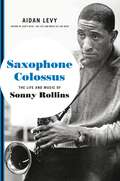- Table View
- List View
Scarred: But Not For Life
by Kim McCuskerBrutally dragged 780 metres beneath a taxi, a young woman’s inspiring story of survival, courage, and the will to live. 13 September 2011. The story would shock thousands and be remembered by many for years to come. It would be plastered all over the papers and continue to attract interest well after the shock factor of what happened had passed. Reports and articles would be written, and “facts”, as given to reporters by some of those involved and willing to be interviewed, would be recounted and repeated in all forms of public media over the months and even years that followed. And although these versions would generate widespread outrage, none was entirely accurate. The stories were about me. I was there. I am Kim McCusker, “the girl who was dragged by a taxi”. This, as I experienced it, is the true version of events.
Scarp
by Nick PapadimitriouNick Papadimitriou has spent a lifetime living on the margins, walking and documenting the landscapes surrounding his home in Child's Hill, North London, in a study he calls Deep Topography. Part meditation on nature and walking, part memoir and part social history, his arresting debut is first and foremost a personal inquiry into the spirit of a place: a 14-mile broken ridge of land on the fringes of Northern London known as Scarp. Conspicuous but largely forgotten, a vast yet largely invisible presence hovering just beyond the metropolis, Scarp is a vast storehouse of regional memory. We join the author as he explores and reimagines this brooding, pregnant landscape, meticulously observing his surroundings, finding surprising connections and revealing lost slices of the past. SCARP captures the satisfying experience of a long, reflective walk. Whether talking about the beauty of a bird or a telegraph pole, deaths at a roundabout or his own troubled past, Papadimitriou celebrates the poetry in the everyday. His captivating prose reveals that the world around us is alive and intrinsically valuable in ways that the trappings of day-to-day life lead us to forget, and allows us to re-connect with something more authentic, more immediate, more profound.
Scarlett’s Secret: A Real-life Short Story By Casey Watson
by Casey WatsonBestselling author and foster carer Casey Watson tells the shocking and deeply moving true story of two sisters who carry a terrible secret.
Scarlett Says
by Scarlett MoffattQueen of the SofaQueen of the JungleQueen of the one-liner The Sunday Times Number 1 Bestseller 'Scarlett Says is absolutely brilliant and really funny. Half autobiography, half mad woman on a roundabout shouting at the traffic.' - Alan Carr'My absolutely favourite Goggleboxer has a book out and it's brilliant.' - Richard Osman We all love a bit of Scarlett Moffatt. After years of making us crack up on Channel 4’s Gogglebox, in 2016 she won the nation over with her wit, and genuine, no-nonsense attitude to life, as she was crowned Queen of the Jungle on I’m a Celebrity Get me out of Here.In Scarlett Says, she takes us through all of life’s biggest issues, from Tinder to tooth fairies and everything in between. This is an honest, revealing and very funny guide to the modern world from everyone’s favourite girl-next-door.
The Scarlet Sisters: My nanna’s story of secrets and heartache on the banks of the River Thames
by Helen Batten‘Oh my goodness – another girl Mrs Swain!’ Clara’s normal iron composure broke and she screamed, ‘No! That’s not the bloody deal!’And that is how my nanna, Bertha Swain, entered the world.When Helen Batten’s marriage breaks down, she starts on a journey of discovery into her family’s past and the mysteries surrounding her enigmatic nanna’s early life. What she unearths is a tale of five feisty red heads struggling to climb out of poverty and find love through two world wars. It’s a story full of surprises and scandal – a death in a workhouse, a son kept in a box, a shameful war record, a clandestine marriage and children taken far too soon. It’s as if there is a family curse. But Helen also finds love, resilience and hope – crazy wagers, late night Charlestons and stolen kisses. As she unravels the story of Nanna and her scarlet sisters, Helen starts to break the spell of the past, and sees a way she might herself find love again.
The Scarlet Sisters: Sex, Suffrage, and Scandal in the Gilded Age
by Myra MacPhersonA fresh look at the life and times of Victoria Woodhull and Tennie Claflin, two sisters whose radical views on sex, love, politics, and business threatened the white male power structure of the nineteenth century and shocked the world. Here award-winning author Myra MacPherson deconstructs and lays bare the manners and mores of Victorian America, remarkably illuminating the struggle for equality that women are still fighting today. Victoria Woodhull and Tennessee "Tennie" Claflin-the most fascinating and scandalous sisters in American history-were unequaled for their vastly avant-garde crusade for women's fiscal, political, and sexual independence. They escaped a tawdry childhood to become rich and famous, achieving a stunning list of firsts. In 1870 they became the first women to open a brokerage firm, not to be repeated for nearly a century. Amid high gossip that he was Tennie's lover, the richest man in America, fabled tycoon Cornelius Vanderbilt, bankrolled the sisters. As beautiful as they were audacious, the sisters drew a crowd of more than two thousand Wall Street bankers on opening day. A half century before women could vote, Victoria used her Wall Street fame to become the first woman to run for president, choosing former slave Frederick Douglass as her running mate. She was also the first woman to address a United States congressional committee. Tennie ran for Congress and shocked the world by becoming the honorary colonel of a black regiment. They were the first female publishers of a radical weekly, and the first to print Karl Marx's Communist Manifesto in America. As free lovers they railed against Victorian hypocrisy and exposed the alleged adultery of Henry Ward Beecher, the most famous preacher in America, igniting the "Trial of the Century" that rivaled the Civil War for media coverage. Eventually banished from the women's movement while imprisoned for allegedly sending "obscenity" through the mail, the sisters sashayed to London and married two of the richest men in England, dining with royalty while pushing for women's rights well into the twentieth century. Vividly telling their story, Myra MacPherson brings these inspiring and outrageous sisters brilliantly to life.
Scar Tissue: Der Sänger Der Red Hot Chili Peppers - Die Autobiographie
by Anthony KiedisIn SCAR TISSUE Anthony Kiedis, charismatic and highly articulate frontman of the Red Hot Chili Peppers, recounts his remarkable life story, and the history of the band itself. Raised in the Midwest, he moved to LA aged eleven to live with his father Blackie, purveyor of pills, pot, and cocaine to the Hollywood elite. After a brief child-acting career, Kiedis dropped out of U.C.L.A. and plunged headfirst into the demimonde of the L.A. underground music scene. He formed the band with three schoolfriends - and found his life's purpose. Crisscrossing the country, the Chili Peppers were musical innovators and influenced a whole generation of musicians. But there's a price to pay for both success and excess and in SCAR TISSUE, Kiedis writes candidly of the overdose death of his soul mate and band mate, Hillel Slovak, and his own ongoing struggle with an addiction to drugs. SCAR TISSUE far transcends the typical rock biography, because Anthony Kiedis is anything but a typical rock star. It is instead a compelling story of dedication and debauchery, of intrigue and integrity, of recklessness and redemption.
A Scar is Also Skin: A memoir of stroke, heart attack and remaking
by Ben MckelveyFor the first twenty-seven years of his life, Ben McKelvey didn't spend too much time thinking about his brain, nor much about trauma. He was fit, carefree and happy working as a magazine journalist, writing listicles and doing celebrity junket interviews.Then one day, while boxing, he suffered a stroke. In the time it took for a left hook to be thrown, Ben disconnected from language and therefore the world. He wanted nothing more than to go back to normal life and, after a time, it looked he had. He spoke again in a few days, read in a few weeks and then, in months, returned to his listicles and junkets. Only normal life no longer felt normal. Ben's brain had changed, and so had he.Ben's stroke was followed a few years later by a startling heart attack. A crisis followed, and surgeries: dangerous, painful and scarring. On an unsteady path of recovery, Ben started to question everything about his life. He wondered what makes us who we are, and what role family, fate and physiology plays. He wondered what a good life looks like.While still weak, thin and questioning, a letter arrived from the Australian Defence Force. It was an invitation to embed with Australian forces in Iraq, and also an invitation to a new career and a calling, one that would allow Ben to ask deep questions about life, connection and the morality of people who have also visited the precarious edge of human experience. Combining autobiography, reportage and science, Ben Mckelvey tells his personal story, along with research about psychology, physiology and neuropathology. He shares intimate stories about people who have dealt with illness or trauma and some who are moulding our understanding of ourselves. In the telling, Ben investigates trauma, change and resilience. This is a powerful book for anyone who has ever been broken, and hoped to find themselves remade.
Scandals of the Royal Palaces: An Intimate Memoir of Royals Behaving Badly
by Tom QuinnGeorge Orwell once said that the British love a really good murder. He might also have said that the only thing the British love more than a good murder is a really good scandal, and best of all are the political and sexual scandals that take place in Britain’s royal palaces.Dozens of royal scandals have been covered up or suppressed to some degree by an establishment that is famous for its determination to keep royal secrets, well, secret. This book is the first in-depth look at the outrageous behaviour not just of the royals themselves but also of palace officials, courtiers, household servants and hangers-on.Covering existing royal palaces in some depth as well as taking a look at scandals linked to long-vanished royal residences, such as Whitehall, Nonsuch and Kings Langley, Scandals of the Royal Palaces also includes new information on well-known and not-so-well-known scandals, including those that have only recently been revealed in detail through the release of previously secret official papers.As this glorious romp of a book reveals, scandal and the royal family have always been bedfellows, and the key to the sometimes extraordinary scandals the royal family have become involved in are the palaces in which they live.
A Scandalous Life: The Biography Of Jane Digby (text Only)
by Mary S. LovellThe biography of Jane Digby, an ‘enthralling tale of a nineteenth-century beauty whose heart – and hormones – ruled her head.’ Harpers and Queen
The Scandalous Freddie McEvoy: The true story of the swashbuckling Australian rogue
by Frank WalkerSwashbuckler, daredevil racing-car champion, Winter Olympian, gambler, smuggler, scoundrel, stud and suspected Nazi agent who died a mysterious death - this is the fascinating story of the scandalous Freddie McEvoy.Born in Melbourne in 1907, Freddie's life took him from socialising with a young Errol Flynn in Sydney and on to the French Riviera in the heady years leading up to World War II. With his dashing good looks and charm, Freddie lived a swashbuckling life, quickly figuring out his path to easy fortune was through lonely rich women. World War II didn't stop Freddie's hedonistic pursuits - he skipped enlistment for Australia and Britain to party on in Hollywood, where he renewed his friendship with the now infamous Errol Flynn. Always short of cash, Freddie smuggled guns and diamonds on his yacht between California and Mexico and was rumoured to have worked as a spy. It was a life lived large and Freddie's death in 1951 was under the most mysterious circumstances off the coast of Morocco: his body was found naked and scalped . . .Frank Walker, bestselling author of The Tiger Man of Vietnam and Maralinga, has for the first time uncovered the complete, outrageous and incredible true story of Freddie McEvoy, Australia's daredevil lothario.'Freddie was one of the great livers of life. He lived it the way he saw it - he didn't give a hoot.'Errol Flynn'Pleasure is my business.' Freddie McEvoy'an extraordinary yarn . . . finely researched' Sun-Herald on Frank Walker's Ghost Platoon
Scandalous
by Laura DLaura is a bright and ambitious language student at a top university in France. She is also broke. Surfing the internet one evening, she stumbles across an adult website that might just hold the answer to her financial problems - pages of personal ads offering money in exchange for 'female company'. On impulse she responds to one of them . . . and then another and another. When a man called Joe contacts her, prepared to pay €150 for an hour-long meeting, she nervously agrees to his request.Joe will be the first of many clients - men of all ages with urgent needs. And Laura will surprise even herself as she submits to their often bizarre demands in hotel rooms and apartments. But the pressures of leading a double life as student and call girl, and the increasing possessiveness of Joe soon begin to take their toll. In her first year at university, 19-year-old Laura is set to learn more about men, money, sex and herself than she could ever have imagined.
The Scandal of the Century: A thrilling historical biography about the astonishing story of England’s first novel
by Lisa Hilton‘A sweeping, scintillatingly original, exciting exploration of writer, spy, power player, lover Aphra Behn’ Kate Williams, historian and author of Rival Queens: The Betrayal of Mary, Queen of Scots----A CLANDESTINE AFFAIR ‘Whereas the Lady Henrietta Berkeley has been absent from her Father's house since the 20th August last past… AN OUTRAGEOUS ELOPEMENT … and is not yet known where she is, nor whether she is alive or dead. STOLEN LETTERS, SCHEMING SERVANTS These are to give notice That whoever shall find her, so that she may be brought back to her Father, the Earl of Berkeley, they shall have 200 Pounds Reward’ SEX. SENSATION. CELEBRITY. This is The Scandal of the Century - and the true story of the author Aphra Behn, who used a shocking love affair to create the first English novel . . . ----In 1682, a young woman in the throes of a passionate affair flees her parents’ home in Surrey to seek a new life in London. A scandal in its own right, but this is no ordinary young woman: Lady Henrietta Berkeley is the daughter of one of England’s most powerful men, and her lover is her own sister’s husband. As news of this notorious adulteress spreads, her flight, capture and the lawsuit that follow tear through society as the scandal of the century.To Aphra Behn, England's first professional female writer – herself condemned as a scarlet woman of loose morals – Henrietta’s trial would be more than a source of shock and intrigue: it would inspire her to write Love Letters Between a Nobleman and His Sister, an outrageous and bestselling political fiction and arguably the first novel in English literature.Aphra herself is an enigma, the facts about her life continually disputed. By revealing the story of these two rebellious and ruthless women, Lisa Hilton's new history offers a surprisingly original theory on the origins of one of England's most celebrated playwrights. Against the backdrop of seventeenth-century England, with its strict traditional conventions of love, duty and identity, The Scandal of the Century shows just how far both women will go to break free.
Scandal!: An Explosive Exposé of the Affairs, Corruption and Power Struggles of the Rich and Famous (World Famous Ser.)
by Colin Wilson Damon WilsonWhat makes a good scandal? Money, politics and power, and a huge dose of media interest. Scandal reigns in the world of politics, celebrity, business, religion, royalty and art, and this book covers it all - from Watergate to Michael Jackson, Diana to Oscar Wilde. Distinguished writer Colin Wilson delves into the murky intrigues of British and American life to bring the most scandalous secrets to light.Containing brand new chapters on Michael Jackson, ENRON, the death of David Kelly, the Catholic Church sex scandals and the cash-for-honours scandal, and an updated chapter on OJ Simpson, here are the embarrassing true stories the rich and famous tried but failed to hide.
SBS – Silent Warriors: The Authorised Wartime History
by Saul David‘It is incredibly refreshing to read of these fabulously daring missions … This is a terrific book, written with all the gusto, thrills and heady excitement these SBS operations richly deserve. It really is one of the most enjoyable histories I’ve read in many a year’ James Holland, Daily Telegraph, five stars
Say Only Enough
by Eddie WilliamsOn finding myself redundant at the ripe old age of thirty-seven and, therefore, in need of new employment, an alternative opportunity presented itself, to form a company and start my own business. I had no managerial experience, no previous ambition to form my own company or be my own boss, no entrepreneurial inclinations and no money. With help from a friend, a company was formed. From the combined elements of endurance, resilience, determination, steadfastness, vision, luck, humour and sleepless nights, a very successful company developed. It is now one of the market leaders in its specialist field, and celebrated its 40th anniversary this year. This is not a book offering advice on how to build a successful business. It is more a light-hearted romp and adventure in doing so. It is one that traces the route via an undulating winding road with hazardous bends and obstructions. The journey provides unfolding opportunities to view the distant horizon, where awaits the lush green valley of the final destination.
Say Nothing: The Harrowing Truth About Auntie's Children
by Josephine DuthieSay Nothing is the moving true story of four neglected siblings who were taken into care following the breakdown of their parents' marriage. Sent to a small croft in the north-east of Scotland, they endured an onslaught of physical and mental abuse at the hands of an elderly, inexperienced foster mother. For ten years the children's cries for help were ignored and misunderstood in the naive social-work climate of the late 1950s, and this heartbreaking personal account of cruelty and neglect reveals the effect this maltreatment had on their ability to adjust to a normal adult life.Say Nothing was written as a voice of support for all abused children who are afraid or were never given the chance to tell their story.
Say Nothing: A True Story Of Murder and Memory In Northern Ireland
by null Patrick Radden KeefeTHE INTERNATIONAL BESTSELLER WINNER OF THE ORWELL PRIZE FOR POLITICAL WRITING ONE OF DUA LIPA'S BEST BOOKS OF THE YEAR ‘The best book I’ve read for a while, it’s fantastic’ John Oliver ‘A must read’ Gillian Flynn One night in December 1972, Jean McConville, a mother of ten, was abducted from her home in Belfast and never seen alive again. Her disappearance would haunt her orphaned children, the perpetrators of this terrible crime and a whole society in Northern Ireland for decades. In this powerful, scrupulously reported book, Patrick Radden Keefe offers not just a forensic account of a brutal crime but a vivid portrait of the world in which it happened. The tragedy of an entire country is captured in the spellbinding narrative of a handful of characters, presented in lyrical and unforgettable detail. A poem by Seamus Heaney inspires the title: ‘Whatever You Say, Say Nothing’. By defying the culture of silence, Keefe illuminates how a close-knit society fractured; how people chose sides in a conflict and turned to violence; and how, when the shooting stopped, some ex-combatants came to look back in horror at the atrocities they had committed, while others continue to advocate violence even today. Say Nothing deftly weaves the stories of Jean McConville and her family with those of Dolours Price, the first woman to join the IRA as a front-line soldier, who bombed the Old Bailey when barely out of her teens; Gerry Adams, who helped bring an end to the fighting, but denied his own IRA past; Brendan Hughes, a fearsome IRA commander who turned on Adams after the peace process and broke the IRA’s code of silence; and other indelible figures. By capturing the intrigue, the drama and the profound human cost of the Troubles, the book presents a searing chronicle of the lengths that people are willing to go to in pursuit of a political ideal, and the ways in which societies mend – or don’t – in the aftermath of a long and bloody conflict.
Say No to the Devil: The Life and Musical Genius of Rev. Gary Davis
by Ian ZackWho was the greatest of all American guitarists? You probably didn’t name Gary Davis, but many of his musical contemporaries considered him without peer. Bob Dylan called Davis “one of the wizards of modern music.” Bob Weir of the Grateful Dead—who took lessons with Davis—claimed his musical ability “transcended any common notion of a bluesman.” And the folklorist Alan Lomax called him “one of the really great geniuses of American instrumental music.” But you won’t find Davis alongside blues legends Robert Johnson and Muddy Waters in the Rock and Roll Hall of Fame. Despite almost universal renown among his contemporaries, Davis lives today not so much in his own work but through covers of his songs by Dylan, Jackson Browne, and many others, as well as in the untold number of students whose lives he influenced. The first biography of Davis, Say No to the Devil restores “the Rev’s” remarkable story. Drawing on extensive research and interviews with many of Davis’s former students, Ian Zack takes readers through Davis’s difficult beginning as the blind son of sharecroppers in the Jim Crow South to his decision to become an ordained Baptist minister and his move to New York in the early 1940s, where he scraped out a living singing and preaching on street corners and in storefront churches in Harlem. There, he gained entry into a circle of musicians that included, among many others, Lead Belly, Woody Guthrie, and Dave Van Ronk. But in spite of his tremendous musical achievements, Davis never gained broad recognition from an American public that wasn’t sure what to make of his trademark blend of gospel, ragtime, street preaching, and the blues. His personal life was also fraught, troubled by struggles with alcohol, women, and deteriorating health. Zack chronicles this remarkable figure in American music, helping us to understand how he taught and influenced a generation of musicians.
Say No to the Devil: The Life and Musical Genius of Rev. Gary Davis
by Ian ZackWho was the greatest of all American guitarists? You probably didn’t name Gary Davis, but many of his musical contemporaries considered him without peer. Bob Dylan called Davis “one of the wizards of modern music.” Bob Weir of the Grateful Dead—who took lessons with Davis—claimed his musical ability “transcended any common notion of a bluesman.” And the folklorist Alan Lomax called him “one of the really great geniuses of American instrumental music.” But you won’t find Davis alongside blues legends Robert Johnson and Muddy Waters in the Rock and Roll Hall of Fame. Despite almost universal renown among his contemporaries, Davis lives today not so much in his own work but through covers of his songs by Dylan, Jackson Browne, and many others, as well as in the untold number of students whose lives he influenced. The first biography of Davis, Say No to the Devil restores “the Rev’s” remarkable story. Drawing on extensive research and interviews with many of Davis’s former students, Ian Zack takes readers through Davis’s difficult beginning as the blind son of sharecroppers in the Jim Crow South to his decision to become an ordained Baptist minister and his move to New York in the early 1940s, where he scraped out a living singing and preaching on street corners and in storefront churches in Harlem. There, he gained entry into a circle of musicians that included, among many others, Lead Belly, Woody Guthrie, and Dave Van Ronk. But in spite of his tremendous musical achievements, Davis never gained broad recognition from an American public that wasn’t sure what to make of his trademark blend of gospel, ragtime, street preaching, and the blues. His personal life was also fraught, troubled by struggles with alcohol, women, and deteriorating health. Zack chronicles this remarkable figure in American music, helping us to understand how he taught and influenced a generation of musicians.
Say No to the Devil: The Life and Musical Genius of Rev. Gary Davis
by Ian ZackWho was the greatest of all American guitarists? You probably didn’t name Gary Davis, but many of his musical contemporaries considered him without peer. Bob Dylan called Davis “one of the wizards of modern music.” Bob Weir of the Grateful Dead—who took lessons with Davis—claimed his musical ability “transcended any common notion of a bluesman.” And the folklorist Alan Lomax called him “one of the really great geniuses of American instrumental music.” But you won’t find Davis alongside blues legends Robert Johnson and Muddy Waters in the Rock and Roll Hall of Fame. Despite almost universal renown among his contemporaries, Davis lives today not so much in his own work but through covers of his songs by Dylan, Jackson Browne, and many others, as well as in the untold number of students whose lives he influenced. The first biography of Davis, Say No to the Devil restores “the Rev’s” remarkable story. Drawing on extensive research and interviews with many of Davis’s former students, Ian Zack takes readers through Davis’s difficult beginning as the blind son of sharecroppers in the Jim Crow South to his decision to become an ordained Baptist minister and his move to New York in the early 1940s, where he scraped out a living singing and preaching on street corners and in storefront churches in Harlem. There, he gained entry into a circle of musicians that included, among many others, Lead Belly, Woody Guthrie, and Dave Van Ronk. But in spite of his tremendous musical achievements, Davis never gained broad recognition from an American public that wasn’t sure what to make of his trademark blend of gospel, ragtime, street preaching, and the blues. His personal life was also fraught, troubled by struggles with alcohol, women, and deteriorating health. Zack chronicles this remarkable figure in American music, helping us to understand how he taught and influenced a generation of musicians.
Say No to the Devil: The Life and Musical Genius of Rev. Gary Davis
by Ian ZackWho was the greatest of all American guitarists? You probably didn’t name Gary Davis, but many of his musical contemporaries considered him without peer. Bob Dylan called Davis “one of the wizards of modern music.” Bob Weir of the Grateful Dead—who took lessons with Davis—claimed his musical ability “transcended any common notion of a bluesman.” And the folklorist Alan Lomax called him “one of the really great geniuses of American instrumental music.” But you won’t find Davis alongside blues legends Robert Johnson and Muddy Waters in the Rock and Roll Hall of Fame. Despite almost universal renown among his contemporaries, Davis lives today not so much in his own work but through covers of his songs by Dylan, Jackson Browne, and many others, as well as in the untold number of students whose lives he influenced. The first biography of Davis, Say No to the Devil restores “the Rev’s” remarkable story. Drawing on extensive research and interviews with many of Davis’s former students, Ian Zack takes readers through Davis’s difficult beginning as the blind son of sharecroppers in the Jim Crow South to his decision to become an ordained Baptist minister and his move to New York in the early 1940s, where he scraped out a living singing and preaching on street corners and in storefront churches in Harlem. There, he gained entry into a circle of musicians that included, among many others, Lead Belly, Woody Guthrie, and Dave Van Ronk. But in spite of his tremendous musical achievements, Davis never gained broad recognition from an American public that wasn’t sure what to make of his trademark blend of gospel, ragtime, street preaching, and the blues. His personal life was also fraught, troubled by struggles with alcohol, women, and deteriorating health. Zack chronicles this remarkable figure in American music, helping us to understand how he taught and influenced a generation of musicians.
Say No to the Devil: The Life and Musical Genius of Rev. Gary Davis
by Ian ZackWho was the greatest of all American guitarists? You probably didn’t name Gary Davis, but many of his musical contemporaries considered him without peer. Bob Dylan called Davis “one of the wizards of modern music.” Bob Weir of the Grateful Dead—who took lessons with Davis—claimed his musical ability “transcended any common notion of a bluesman.” And the folklorist Alan Lomax called him “one of the really great geniuses of American instrumental music.” But you won’t find Davis alongside blues legends Robert Johnson and Muddy Waters in the Rock and Roll Hall of Fame. Despite almost universal renown among his contemporaries, Davis lives today not so much in his own work but through covers of his songs by Dylan, Jackson Browne, and many others, as well as in the untold number of students whose lives he influenced. The first biography of Davis, Say No to the Devil restores “the Rev’s” remarkable story. Drawing on extensive research and interviews with many of Davis’s former students, Ian Zack takes readers through Davis’s difficult beginning as the blind son of sharecroppers in the Jim Crow South to his decision to become an ordained Baptist minister and his move to New York in the early 1940s, where he scraped out a living singing and preaching on street corners and in storefront churches in Harlem. There, he gained entry into a circle of musicians that included, among many others, Lead Belly, Woody Guthrie, and Dave Van Ronk. But in spite of his tremendous musical achievements, Davis never gained broad recognition from an American public that wasn’t sure what to make of his trademark blend of gospel, ragtime, street preaching, and the blues. His personal life was also fraught, troubled by struggles with alcohol, women, and deteriorating health. Zack chronicles this remarkable figure in American music, helping us to understand how he taught and influenced a generation of musicians.
Say No to the Devil: The Life and Musical Genius of Rev. Gary Davis
by Ian ZackWho was the greatest of all American guitarists? You probably didn’t name Gary Davis, but many of his musical contemporaries considered him without peer. Bob Dylan called Davis “one of the wizards of modern music.” Bob Weir of the Grateful Dead—who took lessons with Davis—claimed his musical ability “transcended any common notion of a bluesman.” And the folklorist Alan Lomax called him “one of the really great geniuses of American instrumental music.” But you won’t find Davis alongside blues legends Robert Johnson and Muddy Waters in the Rock and Roll Hall of Fame. Despite almost universal renown among his contemporaries, Davis lives today not so much in his own work but through covers of his songs by Dylan, Jackson Browne, and many others, as well as in the untold number of students whose lives he influenced. The first biography of Davis, Say No to the Devil restores “the Rev’s” remarkable story. Drawing on extensive research and interviews with many of Davis’s former students, Ian Zack takes readers through Davis’s difficult beginning as the blind son of sharecroppers in the Jim Crow South to his decision to become an ordained Baptist minister and his move to New York in the early 1940s, where he scraped out a living singing and preaching on street corners and in storefront churches in Harlem. There, he gained entry into a circle of musicians that included, among many others, Lead Belly, Woody Guthrie, and Dave Van Ronk. But in spite of his tremendous musical achievements, Davis never gained broad recognition from an American public that wasn’t sure what to make of his trademark blend of gospel, ragtime, street preaching, and the blues. His personal life was also fraught, troubled by struggles with alcohol, women, and deteriorating health. Zack chronicles this remarkable figure in American music, helping us to understand how he taught and influenced a generation of musicians.
Saxophone Colossus: The Life and Music of Sonny Rollins
by Aidan Levy**Winner of the American Book Award (2023)** **Longlisted for the PEN/Jacqueline Bograd Weld Award (2023)** The long-awaited first full biography of legendary jazz saxophonist and composer Sonny Rollins Sonny Rollins has long been considered an enigma. Known as the &“Saxophone Colossus,&” he is widely acknowledged as one of the greatest jazz improvisers of all time, winning Grammys, the Austrian Cross of Honor, Sweden&’s Polar Music Prize and a National Medal of Arts. A bridge from bebop to the avant-garde, he is a lasting link to the golden age of jazz, pictured in the iconic &“Great Day in Harlem&” portrait. His seven-decade career has been well documented, but the backstage life of the man once called &“the only jazz recluse&” has gone largely untold—until now. Based on more than 200 interviews with Rollins himself, family members, friends, and collaborators, as well as Rollins&’ extensive personal archive, Saxophone Colossus is the comprehensive portrait of this legendary saxophonist and composer, civil rights activist and environmentalist. A child of the Harlem Renaissance, Rollins&’ precocious talent landed him on the bandstand and in the recording studio with Bud Powell, Thelonious Monk, Charlie Parker, Miles Davis and Dizzy Gillespie, or playing opposite Billie Holiday. An icon in his own right, he recorded Tenor Madness, featuring John Coltrane; Way Out West; Freedom Suite, the first civil rights-themed album of the hard bop era; A Night at the Village Vanguard; and the 1956 classic Saxophone Colossus. Yet his meteoric rise to fame was not without its challenges. He served two sentences on Rikers Island and won his battle with heroin addiction. In 1959, Rollins took a two-year sabbatical from recording and performing, practicing up to 16 hours a day on the Williamsburg Bridge. In 1968, he left again to study at an ashram in India. He returned to performing from 1971 until his retirement in 2012. The story of Sonny Rollins—innovative, unpredictable, larger than life—is the story of jazz itself, and Sonny&’s own narrative is as timeless and timely as the art form he represents. Part jazz oral history told in the musicians&’ own words, part chronicle of one man&’s quest for social justice and spiritual enlightenment, this is the definitive biography of one of the most enduring and influential artists in jazz and American history.
